Star Date: January 2009
India: Maharashtra & Almost Mumbai
Hello Dear Family & Friends!
Ke a Hol He!
(Hello! Desert nomads)


‘Weekend’ sadhus. Well dressed and wanting ‘baksheesh’ (money)
these guys hang around temples and are a colorful addition
to the scene, but aren’t true ‘holy men’.
(Mahatma Gandhi (1869 – 1948) Indian national leader.)
Beating drums, temple priests chanting, bells ringing, fragrant flower garlands, smoking incense, loudspeakers blaring ear shattering Hindi songs; all add percussion to the music of life. One cannot talk of India without acknowledging the lifeblood of spirituality and religions pulsing through her veins. There is a temple, ashram, lonely lingam draped with flowers, or colorful shrine, on every corner. Symbols, one of our interests and a lifelong study of Joseph, accentuate the sea of culture with the Hindu Ohm, Islam’s crescent moon, the Jain (whirling sun) swastika, the Zoroastrian’s fire, the Christian’s cross, the Parsi vulture, the Jewish star, the Sikh’s sword and the Buddhist wheel of dharma. All originating from the same source, an ancient but simple worship of the sun and creation, these symbols are interchangeable and come in all colors, shapes and sizes, with glitzy flashing lights and transient fluorescent paints, offsetting permanent stone carvings from centuries past. Indian guru Krishnamurti said, ” When one loses their deep intimate relationship with nature then temples, mosques, and churches become important…” As populations explode around the world, nature gets crushed under the heavy load of humanity. The clanging of bells or ‘busyness’ of a religious ritual certainly provide a distraction from life that the silence of nature doesn’t.
In India there is a ceremony or ritual to suit every taste. Hindus are remarkably accepting of other faiths for they offer thousands of different paths to the divine. Buddhism teaches control of the mind, Jainism non violence to all living creatures, Sikhs display spiritual strength, Sufis find answers within and revel in praising God through music. Gurus such as Sai Baba, Sri Aribindo or Osho have attracted thousands of devotees looking for a quick fix of happiness, enlightenment or as with the Hugging Mother, unconditional love. Islam shows unparalleled hospitality to strangers and Christianity, what does it stand for? Generalizations are just that. Christianity has, in India, offers an alternative for people unfortunate enough to be born into a lower caste. For only a small donation new converts are promised freedom from the bondage of the caste system. Mass conversions make a loud statement and in fact India now exports priests to America, where churches are dying a slow death.
Whatever the religion is, it is really a person’s actions that speak louder than the rhetoric or the religious banner they stand behind. What message does our life give to those around us? There are many roads leading to the truth, and many answers are awaiting you in India, if one has the patience to persevere and search. The choice is ours. One thing for sure, India and the world in general would be a drab place without the riotous spice of religions and their rituals.
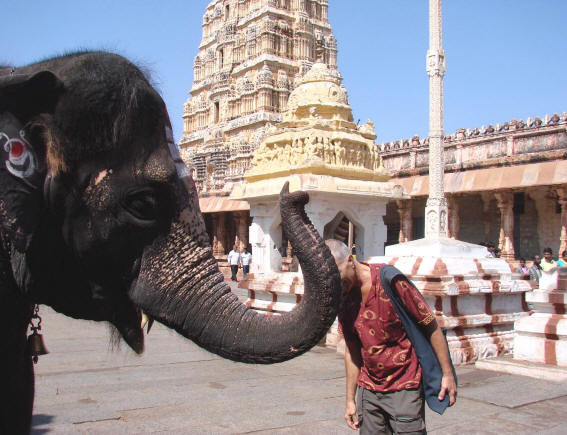
Joseph being blessed by a temple elephant. If a devotee puts 5 cents or more in the elephant’s trunk this real character, full of personality, would bonk you on the head and bless you. Considered wise and holy creatures, elephants are a big part of Hindu ceremonies. This friendly gal got all excited and danced when you slipped her a banana or a piece of coconut.
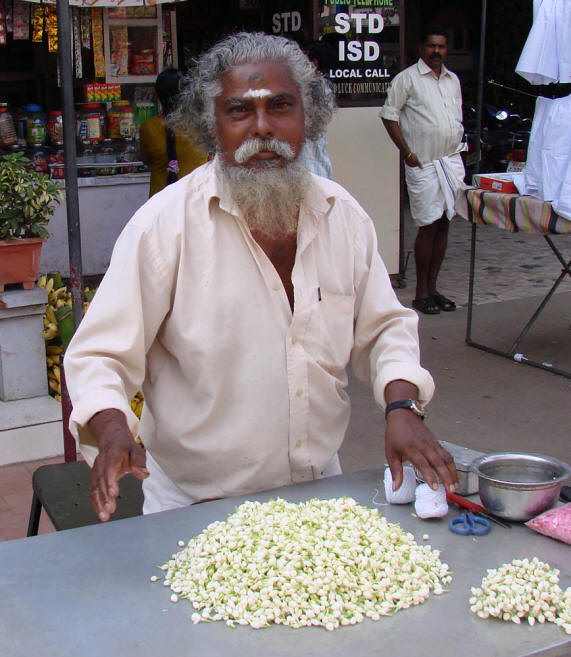
A serene, gentle flower vendor outside a small temple.
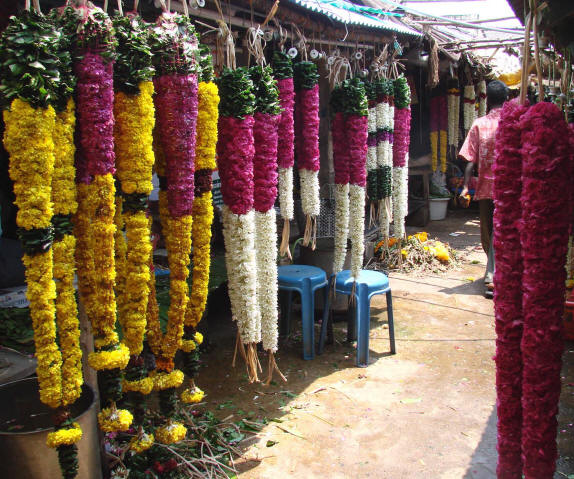
Garlands of fresh flowers drape the stalls surrounding Indian temples. As with the Hawaiian Lei, fresh flowers represent the impermanence of life.
Sadhus, the holy men or saints of Hinduism, fit this job description. They abandon everything and everyone they know and are mourned as dead by their families. They devote their lives to God, reprogramming their minds and bodies through renunciation, celibacy, discipline, meditation, yoga, deprivation and secret tantric practices. This sounds good in theory anyways. (click here for some of our favorite sadhus – bottom of Oct 08 page) The crowning glories are the eccentrics who may be seen lurking around temples or down side streets: some of our favorites have been guys with heads buried in dirt for hours without suffocating, those with floor length dreads sporting monkeys as hats, naked sadhus wearing only paints as bright clothing, and the really extreme ones, ‘fakirs’ who hold a pose for years on end resulting in atrophied limbs, proving to the crowd that their body holds little importance to them. Often ragged and dirty they are kept alive by donations in their water/food bowl. Regularly they don’t remember what hardship they are enduring, as whiffs of hash create the dream world they covet amid the confusion of India. We even read an article describing one such sadhu we had spent an afternoon with. Well read and intelligent on the inside, his theatrics and extreme dress and markings had earned him a reputation that preceded him. Called a fake in the article, brought up the question, “What is a real sadhu anyways?” Certainly our friend had done more to earn his credentials than the modern ‘yuppie’ sadhus who dress in orderly orange robes, faces painted and hands outstretched for ‘baksheesh’ or money. The ‘greatest sadhu show on earth’ is at the Kumbh Mela, when over 12 million Hindu pilgrims gather every 12 years in a writhing mass of humanity to wash away their sins in the Ganges River. After almost a year in India I cringe to think of the sheer numbers, opting instead for a glimpse of spiritual bliss in the peaceful mountains of the Himalayas. To each his own.
Another entertaining splash of religious color are the brightly dressed or painted cows, ‘holy cows’, parading along with their owners playing flutes or drums. All of a sudden one such musician eclectically broke into the haunting melody of Titanic. Although these religions have controlled society and ruled for centuries, was this melancholy tune predicting the future? Many worshippers here seem more interested in watching each other or checking their cell phones than sincerely going through the rituals of worship passed from generation to generation. Temple priests look bored, car dashes have portable alters with flashing lights, and time in the temples or churches is being replaced by glitzy billboards or blaring television commercials promising happiness with the latest purchase. Bollywood stars are the new saints and flashy gurus attract devotees with promise of bliss and the fast track to enlightenment. Where will all this lead? India’s exotic, accepting culture has resisted change for thousands of years, but the winds of change are blowing.
It doesn’t take millions, as with the Kumbh Mela, to make an impression as one travels this land of contrasts. In India one is able to find beauty in the small, simple things: the bright saris of the women hauling road rock on their head, vibrant fruits and vegetables in a local market, rich smelling curries cooking at curb side stands, a rainbow of ‘tika’ powder and bright flower garlands outside a temple, a flickering butter lamp in a small Ganesh or Shiva shrine of a dark street, the smile of a street beggar with twisted limbs or the antics of an elephant decorated with bright chalk and bells. This land is an overload to the senses. Traveling in India presents the full spectrum from utter frustration to wonder and amazement, and the thought of leaving brings tears to my eyes. After almost a year we know India better. We fit better in her skin. Things that made our heads spin now don’t even get our attention. Thanks, Mother India for the hard learned lessons.
It is not surprising that such shining examples of love as Mother Theresa or of nonviolence as Mahatma Gandhi hail from India. Acceptance of others and nonviolence is written on India’s soul. Gandhi was greatly influenced by the nonviolence or ‘ahimsa’ of Jainism. An interesting part of the exhibit at Gandhi’s Sabarmati Ashram along the river in Ahmedabad was him sharing his heartfelt feelings towards his loving wife, Kasturba. She died in jail, 5 years before Gandhi was assassinated. He was deeply saddened by her death. She didn’t have an easy life living in Gandhi’s shadow. He revealed that he was inspired by her power with compassion, rather than from her ego. Her peaceful opposition to Gandhi’s control opened Bapu’s eyes. It was her non-cooperation to his husbandly control that inspired him to follow her example by encouraging non violence and passive resistance while leading the movement for India’s independence from Britain. On being asked for his view on Western civilization: “I think it would be a good idea.” We all have to remember to lighten up and keep smiling!
Gandhi claimed that non-violence is not a garment to be put on and off at will. Its “seat is in the heart and it must be an inseparable part of our very being”. This appealed to the essence of Hindu culture and their all encompassing acceptance of differences around them. Millions followed the example of this great teacher and independence through non violence was achieved. Where is our dear ‘bapu’ today?
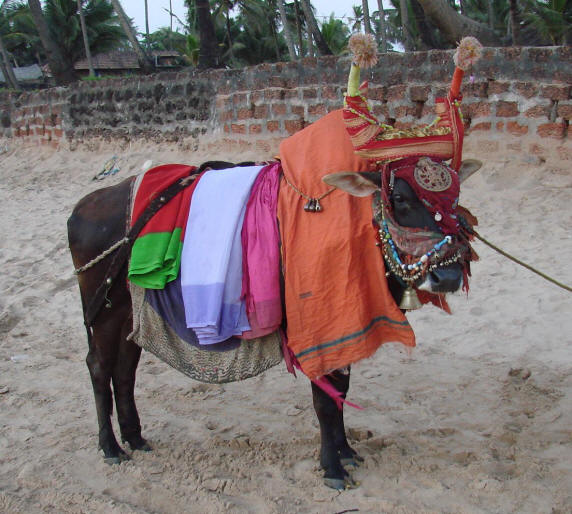
A flamboyant Holy Cow!
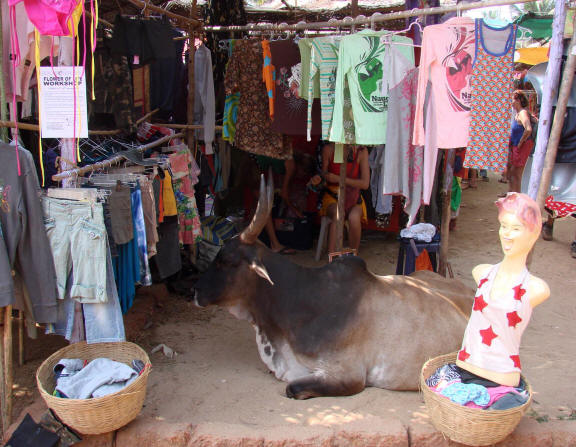
A good example of the power of these wandering deities. This holy cow decided to sleep in the shade of a vendor’s stall and literally closed shop and any chance of business for over 2 hours.

A hidden Buddha in the mysterious Ajanta Caves.
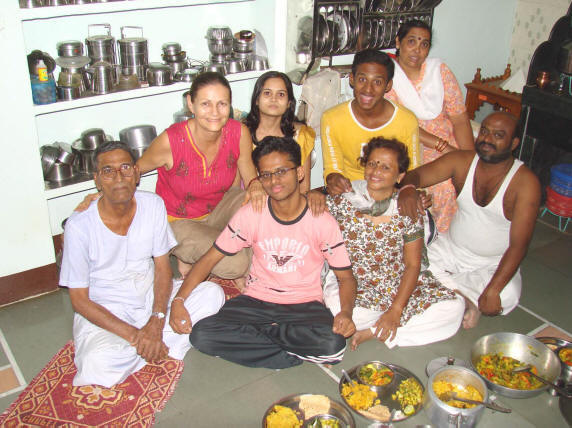
Devchand, Pravin, Pratibha, Vijay and Ajay, friends, relatives and 85 year old Grandpa enjoying a meal we cooked together, after being welcomed into their home, off the bus to Dhulia, to spend the night. Wonderful salt of the earth people! Let’s focus on the good being done in the world, not the bad coverage on the news and CNN.

Heading home with wood to cook dinner.
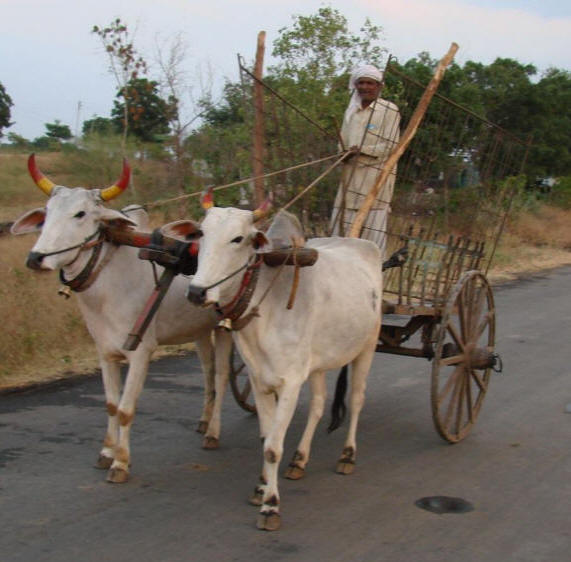
This farmer was extremely proud to have us take a photo of his unique wagon and team.
The thing that struck us most when arriving in Pune (pronounced like Puna on the Big Island of Hawaii) were the unbelievably loud brass bands, complete with red and blue uniforms, sporting gleaming brass buttons and plumed hats, like something out of a Norman Rockwell painting. Winter wedding season had arrived with gusto. Blaring brass bands, buses full of chatting guests, and grooms (having only met their fiancé’s one time) nervously riding to the ceremony on a white horse are all part of tradition. Women in colorful new saris were busily fussing with the dozens of bangles and red saris trimmed in gold of the brides. We have attended several wedding in our travels but usually only have endurance for a few hours. Three to five days of celebrations leaves everyone absolutely exhausted but satiated and happy.
Two nights in Pune and week in Mumbai (2 hours away) – great ‘plan’. We talked with a young man on the bus into the city and decided to meet him on the weekend to exchange software. Thank you! We would have been in Mumbai the night of the horrendous attack by criminals on innocent citizens. Our weekend meeting never happened because the young man’s uncle was shot in Mumbai and he went to the hospital to be with him. Travelers were told to stay put, and keep a low profile, as westerners were being targeted. Violence such as this is hard to comprehend. Pune has an enormous army contingent so we figured it would be a safe place to lay low. This was the act of criminals to get attention worldwide. It worked. No one even pays attention to places around the world unless there is a disaster or an act of violence. It was interesting to note that all the Muslims we talked to were appalled by the attack and their community refused to have anything to do with the burials of the men shot by police. When we first arrived in Pune we stayed in the old Muslim section, complete with enormous goats on ropes, happily eating themselves towards the center platter for Eid al-Adha holiday. It was from our balcony here that we observed the strange gambling event of water buffalo fighting in the local park.
The climate here is good all year round and we enjoyed the warm days and autumn like evenings. Once we discovered the ‘holy grail’ of the vegetarian German Bakery and the quiet tree lined lanes of Koregaon we moved over to an apartment building across town and settled in. This allowed us to relax, boost our health and learn more about the Indian health sciences of homeopathy, naturopathy and the allopathy of Ruby Hall. I spent 3 days exploring different forms of meditation at Osho’s controversial ashram, famous for requiring an aids test to attend and the active meditations before quiet sitting, aimed at tiring out the overactive western mind before a period of contemplation. Besides all the dancing and music I was completely taken by the Sufi whirling meditation under the new pyramid shaped main hall. Gatherings there can have hundreds of followers but this morning event brought out only about a dozen hardy souls, several complete with the full garb of wide red skirts flaring and tall hats. We are all observers of this great dance called life. Spinning nonstop for about 30 minutes, the smiling eye of the storm remains totally calm and peaceful while the whirling dance of life around blends into a blur of color. The large dark pyramid with morning light streaming in the windows, highlighting the red costumes of the dancers spinning to the Sufi music, is an impression I will have with me forever. At the ashram it was common to have lunch or join sessions with people from all over the world. Attendees hail from over 175 countries. One day, for example, I was joined by fellow explorers from Iraq, Russia, South Africa, Italy, Israel, Ubekistan and Columbia. A real global community. At the entrance is a quote from Osho: ” What I am doing here is very simple, very ordinary, nothing spiritual in it, nothing sacred. I am not trying to make you holy persons. I am simply trying to make you sane, intelligent, ordinary people, who can live their lives joyously, dancingly, celebratingly.” I’m not a ‘devotee of gurus’ sort of person but I can say that Osho’s wisdom and impishness is reflected in the smiles of many of those rebels gathered. It all comes from inside each of us anyways, but being surrounded by like minded folk helps. Everyone who visits India is touched in some way by the thread of spirituality running through the fabric of the country. Many are drawn to explore deeper in one or more of the practices that present themselves. No matter what we experience we all go away changed. Mother India leaves her mark on our soul.
And so it goes…………………………………..Next the Konkan Coast, Goa, Bangalore, and a final farewell to India. Until next month let’s pause a minute from our busy, hectic lives long enough to ask ourselves what message our life is giving to the world around us? Thanks for keeping in touch and for sharing this webpage with anyone you think would be interested. We have viewers from all over the world, from China to Europe to the US to down-under Australia to Borneo to mention a few; and don’t forget the 4 regulars from Mongolia every month! So much fun to share the world with all this varied but interested group of global citizens. We are really glad YOU stopped by. Take care!

This snazzy water buffalo, complete with a new horn style, sang us a song while we snapped her picture. Too bad the talent scouts weren’t around.
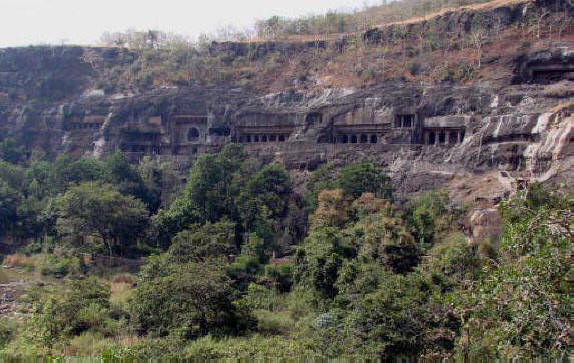
The intriguing hand carved caves of Ajanta follow the bend of the Waghore River and were hidden away until 1819.
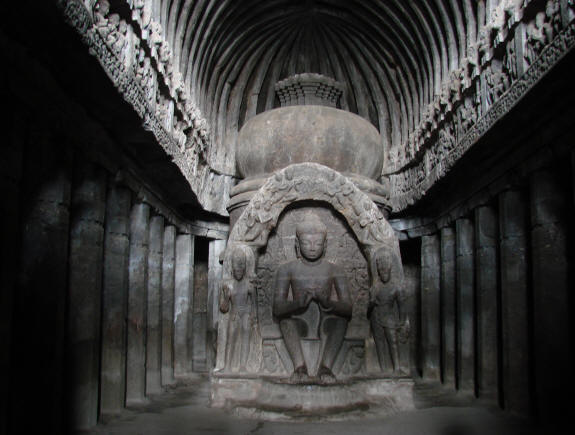
Dating from 200BC, these caves reveal intricately carved temples.
Love, Light & Laughter,
xoxoox Nancy & Joseph
Travel notes:
$1.00US = 50 Rupees
Symbolism:
“The Swastika, The Earliest Known Symbol and It’s Migrations”, by Thomas Wilson, 1894 – Downloadable in a pdf file for Free at www.archive.org. While there do a search on the word: symbolism and see the many wonderful, eye opening books on symbols reoccurring all around you at home and the world over.
Ajanta:
Hotels are 2km from the T-junction. Take a rickshaw (35r) down the road to look at options. They are all about 400r, and basic but fine for a night or two. We enjoyed walking around the villages near our hotel. A rickshaw back to the junction will drop you at the entrance. Walk to the bus which shuttles you to the caves for free. It takes at least 4 hours to see all the caves. Don’t miss the climb to the viewpoint.
Ellora:
Hotel Kailas: A quiet collection of rooms, all prices, phone # 244446. We stayed in one in the back for 400r. There is a nice lawn with chairs overlooking the caves. Their restaurant is expensive.
Maharaja Restaurant: A small local place across the road serves tasty, inexpensive vegetarian food. We cooked here with the jovial brothers.
Pune:
Space “N’ Properties, Popular Heights #4, phone # 91-98900 72796, Burning Ghat Road, Koregaon Park, J-14-15 (475r with kitchen), 2nd floor large window looking out on the lawn and into a big, beautiful tree full of squirrels and kites or small eagles. Great place – the apartment above would also be a splendid place to hangout for a week or more.
M.V & Co – Super Homeopathic Shop, MG Road Tel # 26133110
Dr. V.K. Soni, Amol, Lane #5, Koregaon Park, Phone # 26124906, A remarkable 80 year old “syncropath”.
The Health Shop, 5th Ave Building, Dhole Patil Rd., email:[email protected] (messages for Dr Soni)
Contact Archana Anand Phone# 2611-9679 or 3052 4111
German Bakery, 291 Koregaon Park, A hangout for foreigners, expats and Indians alike. Try a spinach veggie patty and avocado salad for a real treat. Great friendly people and mouth watering food, from fresh wheat grass juice to ‘truthful’ chocolate cake (not at the same time!)

The women of this region of Maharashtra all wore these delicate pearl nose rings, instead of the heavy ones seen in Gujarat.

Our vibrant garlic vendor at the local Ajanta market. She was decorated in the family’s wealth of silver and ivory..

Looking down on the breathtaking Kailasa Temple in Ellora. It is the world’s largest monolith structure, carved by over 7000 laborers during a 150 year period.

It was hard to capture the enormity of this massive structure, carved out of a single rock.

The ever present mischievous temple dwellers, represented by the god, Hanuman.
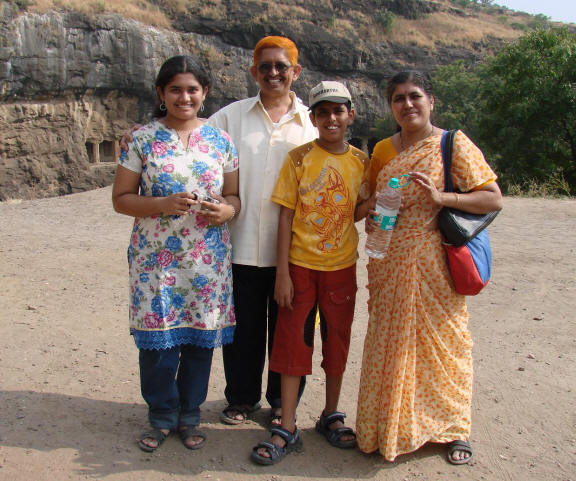
A pleasant family from Mumbai, enjoying the wonders of Ellora Caves. We loved Dad’s wild “doo”.

Showing their love of Gandhi or ‘Bapu” at his ashram.
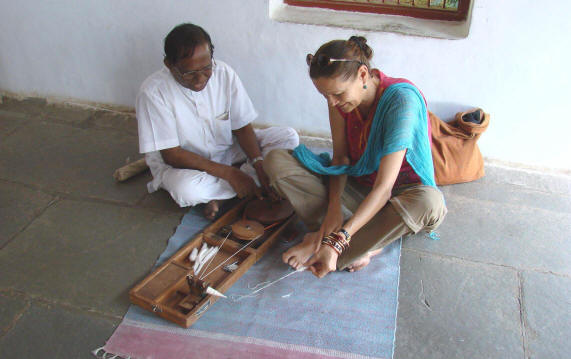
Trying my hand, or should I say feet, at weaving while visiting Gandhi’s Sabarmati Ashram along the river in Ahmedabad. By weaving all his own cloth, he inspired millions to do the same, thus leading the movement towards self sufficiency and away from the tight controls of the British government textile industry. Want quality, healthy food to eat? Stop buying the junk on the shelves. Demand of consumers will improve the supply that is available to purchase.

Everything and everyone gets painted to celebrate this winter festival in the north.

